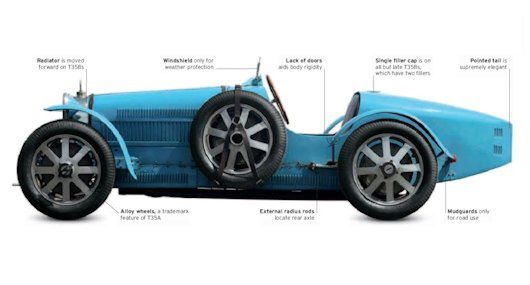The Type 35 Bugatti was emblematic of France’s racing prowess in the 1920s. In motor sport, it was the French equivalent of the legendary British Bentley. The Bugatti was the product of an engineer born into a family of artists: For Ettore Bugatti, aesthetic perfection was as important as technical flair.

Model Bugatti Type 35B, 1927-30
- Assembly Molsheim, France
- Production 38
- Construction Separate chassis; aluminum panels
- Engine 2,262 cc, ohc straight eight-cylinder
- Power 123 bhp at 5,500 rpm
- Transmission Four-speed manual, unsynchronized
- Suspension Semi-elliptic front; rear reversed 1/4
- Brakes Drums front and rear, cable-operated
- Maximum speed 127 mph (204 km/h)
The result was a car of extraordinary beauty in all its details, conservative in some aspects, but of proven effectiveness on the race circuit. The Bugatti Type 35 was-and is-beautiful. But it also earned its keep: In its 1924-1931 lifespan, it claimed 2,000 racing successes. Many of these can be attributed to the supercharged 2,262 cc 35B. The car is instantly recognizable by its eight-spoke, cast-aluminum wheels.

Lightweight and helping to boost brake-cooling, these components made history because they were the first alloy wheels fitted as standard to a production car. The un-supercharged 1,991 cc Type 35 and the Type 35A came with less elaborate 2-liter engines and wire wheels.
The Type 35 was a family of cars, and included an unblown 1,493 cc racer, a supercharged 1,100 cc racer, and various other sub-breeds. There was also a four-cylinder sister car, the Type 37, of which 290 were made. The Type 35 was, however, the more popular, with 336 produced. Of these, a healthy 139 were the more tame 35A, the so-called Técla model.But it is the blown T35B-with its tearing-calico engine note-that stirs the blood the most.

The Bugatti’s lithe lines are hard to fault. The supercharged 35B and 35C have a wider radiator, moved farther forward, as opposed to the more slender radiator of the Type 35, the roadgoing wire-wheeled Type 35A, and the four-cylinder Type 37. The tubular axle, through which the springs pass, is a Bugatti trademark,and the horseshoe-shaped grille is a reflection of Bugatti’s love of all things equestrian.
Artistry from Molsheim
The elliptical logo is found on all Bugattis from 1910 onward and bears the initials of Ettore Bugatti. It was used until the end of Bugatti car production in the early 1950s, and was revived when the marque resurfaced in the 1990s.
Bugatti Type 35B interior
This is the cockpit of a racing car, so creature comforts are absent while space is at a premium. The mechanicals are exposed in the car’s footwells, leading to the presence of leaking oil, not surprising for a racing car where function and weight-saving is more important than comfort. The engine-turned aluminum dashboard is a typical finish of the time, used to good effect by Bugatti.
Bugatti Type 35B exterior
The exquisitely detailed but stark bodywork of the Type 35 is all about function, but with a finesse that makes one recall Ettore Bugatti’s supposed remark that the rival Bentley was a high-speed truck. Arguably the four-cylinder Type 37 is even more pleasing, but it lacks the gutsy muscle of the Type 35. Bugatti had a sure eye for a car’s lines, a gift he passed on to his son Jean, who styled future models.
Under the hood Bugatti 35B
Blistering performance-even by today’s standards-is a given with the supercharged Bugatti. Helping to achieve this is the overhead-camshaft configuration and the use of three valves (two inlet and one exhaust) per cylinder. Free-revving reliability is assured by the use of roller-bearing and ball-bearing mains for the five-bearing crankshaft; the big ends also use roller bearings. Power is transmitted via a multi-plate clutch running in oil.